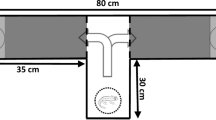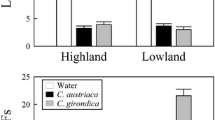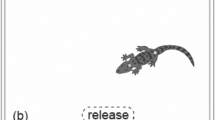Abstract
The abilities of hatchling pine snakes (Pituophis melanoleucus) and king snakes (Lampropeltis getulus) to discriminate the chemical trails of pine and king snakes was investigated inY-maze experiments. Pine snakes were housed for 17 days either with shavings impregnated with pine snake odor, king snake odor, or no odor to test for the effect of experience on choice. Both pine and king snake hatchlings entered the arm with the pine snake odor and did not enter the arm with the king snake odor. The data support the hypothesis that hatchlings of both species can distinguish conspecific odors from other odors and that our manipulation of previous experience was without effect for pine snake hatchlings.
Similar content being viewed by others
References
Brown, W.S. andMaclean, F.M. 1983. Conspecific scent-trailing by newborn timber rattle-snakes,Crotalus horridus.Herpetology 39:430–436.
Brown, W.S., Parker, W.S., andElder, J.A. 1974. Thermal and spatial relationships of two species of coleubrid snakes during hibernation.Herpetology 30:32–38.
Burger, J. 1989. Following of conspecific and avoidance of predator chemical cues by pine snakes (Pituophis melanoleucus).J. Chem. Ecol. 15:799–806.
Burger, J., Zappalorti, R.T., Gochfeld, M., Boarman, W.I., Caffrey, M., Doig, V., Garber, S.D., Lauro, B., Mikovsky, M. Safina, C., andSaliva, J. 1988. Hibernacula and summer den sites of pine snakes (Pituophis melanoleucus) in the New Jersey Pine Barrens.J. Herpetol. 22:425–433.
Burghardt, G.M. 1973. Chemical release of prey attack: Extension to naive newly hatched lizards,Eumeces fasciatus.Copeia 1973:178–181.
Burghardt, G.M. 1980. Behavioral and stimulus correlates of vomeronasal functioning in reptiles: Feeding, grouping, sex, and tongue use, pp. 275–301, in D. Muller-Shwarze, R.M. Silverstein (eds). Chemical Signals in Vertebrates and Aquatic Invertebrates. Plenum Press, New York.
Chiszar, D., Radcliff, C., Boyd, R., Radcliff, A., Yun, H., Smith, H.M., Boyer, R., Atkins, B., andFeiler, F. 1986. Trailing behavior in cottonmouths (Agkistrodon piscivorus).J. Herpetol. 20:269–272.
Cooper, W.E. 1990. Chemical detection of predators by a lizard, the broad-headed skink (Euneces laticeps). J. Exp. Zool.
Cooper, W.E., andVitt, L.J. 1984. Detection of conspecific odors by the female broad-headed skink,Eumeces laticeps.J. Exp. Zool. 229:49–54.
Cooper, W.E., andVitt, L.J. 1985. Responses of the skinks,Eumeces fasciatus andE. laticeps, to airborne conspecific odors: Further appraisal.J. Herpetol. 19:481–486.
Cooper, W.E., andVitt, L.J. 1986a.) Tracking of female conspecific odor trails by male broadheaded skinks (Eumeces laticeps).Ethology 71:242–248.
Cooper, W.E., andVitt, L.J. 1986b. Interspecific odor discrimination by a lizard (Eumeces laticeps).Anim. Behav. 34:367–376.
Cooper, W.E., andVitt, L.J. 1986c. Interspecific odor discriminations among syntopic congeners in scincid lizards (Genus Eumeces).Behavior 97:1–9.
Cooper, W.E., andVitt, L.J. 1986d. Thermal dependence of tongue-flicking and comments on use of tongue flicking as an index of squamate behavior.Ethology 71:177–186.
Cooper, W.E., Garstka, W.R., andVitt, L.J. 1986. Female sex pheromone in the lizardEumeces laticeps.Herpetology 42:361–366.
Ditmars, R.I. 1935. Serpents of the Northeastern States. New York Zoological Society, New York. 40 pp.
Fitch, H.S. 1963. Natural history of the racerColuber constrictor.Univ. Kans. Publ. 15:351–468.
Ford, N.B. 1982. Species specificity of sex pheromone trials of sympatric and allopatric garter snakes (Thamnophis).Copeia 1982:10–13.
Ford, N.B., andObleness, M.L. 1986. Species and sexual specificity of pheromone trails of the garter snake,Thamnophis marcianus.J. Herpetol, 20:259–262.
Ford, N.B., andSchofield, C.W. 1984. Species specificity of sex pheromone trails in the plains garter snake,Thamnophis radix.Herpetologica 40:51–55.
Gehlback, F.R., Watkins, J., andKroll, J. 1971. Pheromone trail following studies of typhlopid, leptotyphlopid, and colubrid snakes.Behavior 40:282–294.
Heller, S., andHalpern, M. 1981. Laboratory observations on conspecific and congeneric scent trailing in garter snakes (Thamnophis).Behav. Neur. Biol. 33:372–377.
Parker, W.S., andBrown, W.S. 1973. Species composition and population changes in two complexes of snake hibernacula in northern Utah.Herpetology 29:319–326.
Von Achen, P.H., andRakestraw, J.L. 1984. The role of chemoreception in the prey selection of neonate reptiles,in R.A. Seigel, L. E. Hunt, J. L. Knight, L. Malaret, and N. L. Zuschlag (eds.). Vertebrate Ecology and Systematics-A Tribute to Harry S. Fitch. Museum of Natural History, University Kansas, Lawrence, Kansas.
Weldon, P.J. 1982. Responses to ophiophagous snakes by snakes of the genusThamnophis.Copeia 1982:788–794.
Weldon, P.J., andBurghardt, G.M. 1979. The ophiophage defensive response in crotaline snakes: Extension to new taxa.J. Chem. Ecol. 5:141–151.
Author information
Authors and Affiliations
Rights and permissions
About this article
Cite this article
Burger, J., Boarman, W., Kurzava, L. et al. Effect of experience with pine (Pituophis melanoleucus) and king (Lampropeltis getulus) snake odors on Y-maze behavior of pine snake hatchlings. Journal of Chemical Ecology 17, 79–87 (1991). https://doi.org/10.1007/BF00994423
Received:
Accepted:
Issue Date:
DOI: https://doi.org/10.1007/BF00994423




